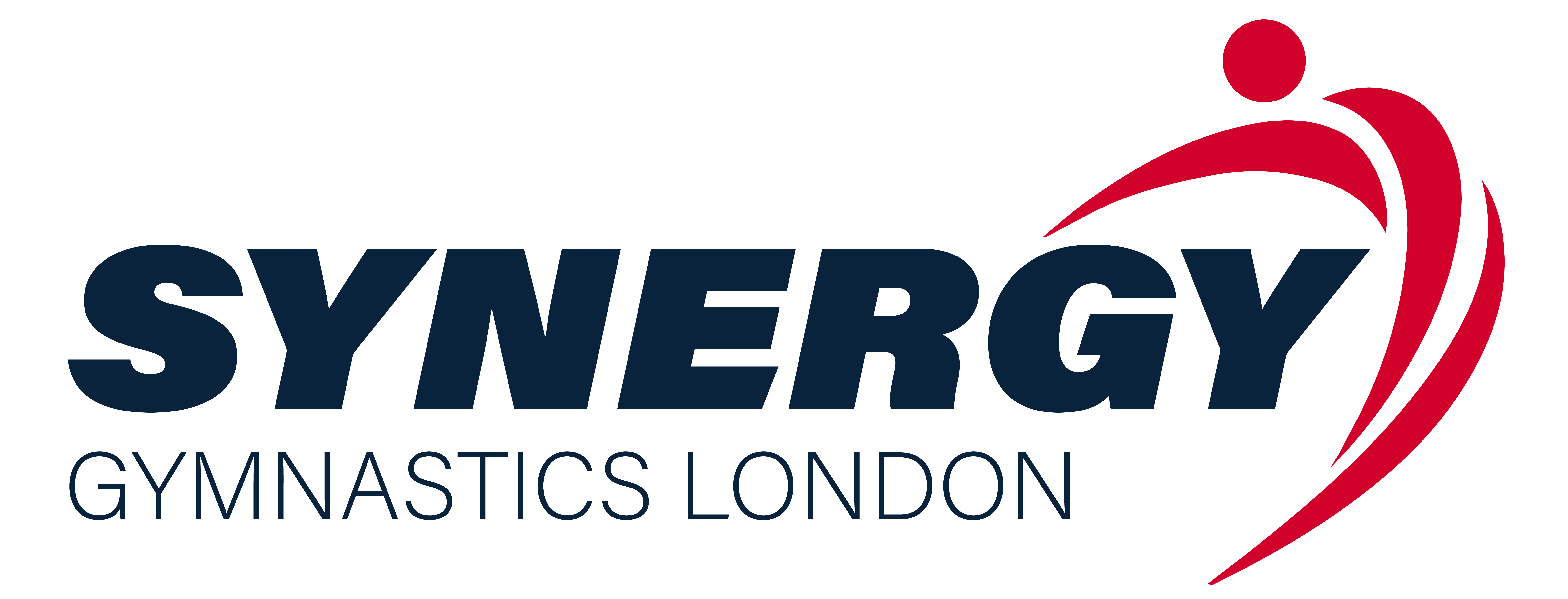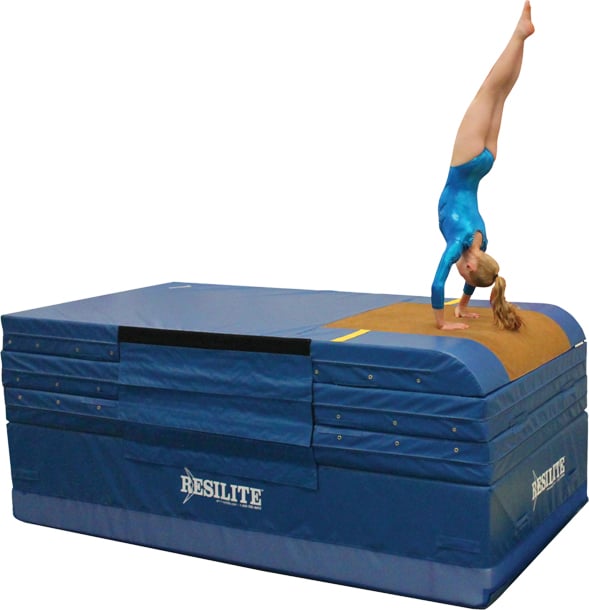
Young gymnasts learning the sport for the first time often ask “How can I practice Vault at home?” Whilst it’s difficult to practice Vault safely outside of a gym, there are some activities which can be done.
If you’re a young gymnast or a parent of one, read on to find drills and progressions that will help improve your Vault.
Disclaimer: Gymnastics carries an inherent level of risk. We always recommend seeking professional coaching in a recognized environment. This article is intended for guidance only and does not replace the need for professional coaching.
Vault Run Up Drills
The approach or run-up sets the tone for the vault. Achieving the right speed and stride length is essential. If the run up is too slow or hits the hurdle step hits the wrong place there is very little chance that the rest of the vault will be performed well.
An experienced coach will instantly know from the run-up whether their gymnast will vault well or not.
1. Marker Drill: Use markers or chalk to set distances on the runway. This helps gymnasts find the ideal number of steps and consistency in their approach.
2. High Knee Drill: Encourage high knees during the run-up. This drill helps improve the approach’s speed and power. Use cones or hurdles to enhance the action of lifting the knees.
3. Acceleration Drill: Start with a slow jog, gradually increasing the speed, ensuring that the final three steps are the most powerful. This helps gymnasts gain control over their speed.
To achieve maximum speed in a run up the gymnast also has to focus on the sprint technique.
- Eyes forward
- An upright posture through the trunk
- Effective arm swing that drives through the elbows
Run Up Drill Equipment
Use this equipment to improve your gymnastics vault.
| Agility Ladder | 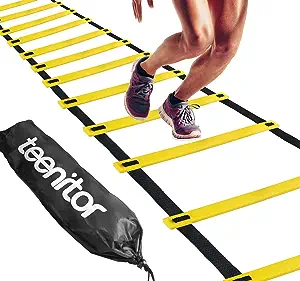 | Check the Latest Price on Amazon |
| Cones | 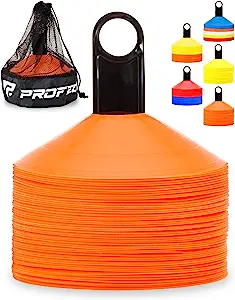 | Check the Latest Price on Amazon |
| Sprint Resistance Parachute | 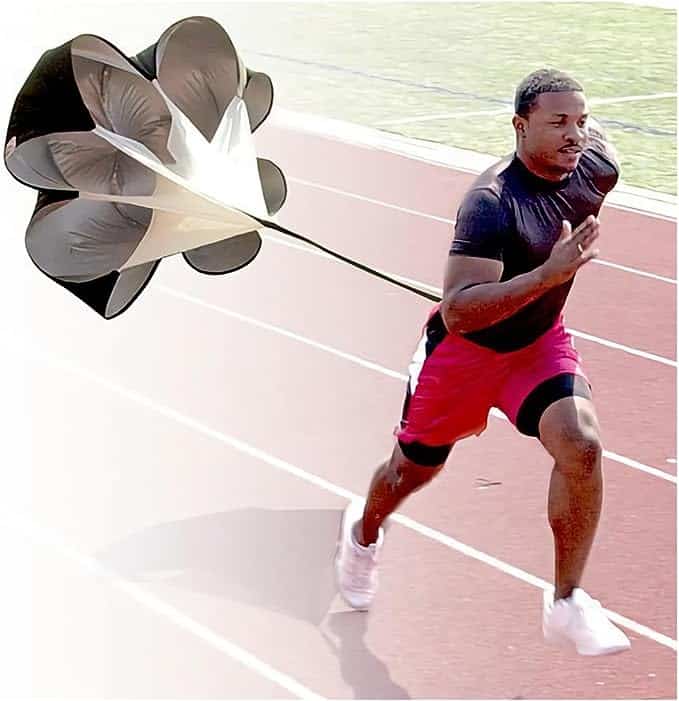 | Check the Latest Price on Amazon |
Springboard Drills
The springboard is where gymnasts convert horizontal speed into vertical lift.
1. Rebound from a platform: Without a run-up, have the gymnast jump onto the springboard aiming to land on a designated spot with a controlled and tight body position and immediately rebound off.
The platform should be slightly higher than the springboard and also pulled back to encourage a longer hurdle step onto the board.
From the platform, the gymnast should stand on one leg before pushing off and landing with both feet together on the springboard. This replicates the last step in a sprint toward the vault.
2. Forward Roll Transfer: Gymnasts start by standing on the board, then performing a forward roll onto a mat. This drill helps with board awareness and teaches how to transfer energy.
As gymnasts become more advanced they will dive roll and eventually somersault from the board.
3. Hops on Board: Hopping on the springboard with one foot or alternating feet helps develop ankle strength and understanding of the board’s bounce.
4. More Plyometrics: Place two springboards next to each other with the low end and shorter edge touching. The gymnast should have one foot on each board and then quickly switch feet positions. Aim to switch as many times as possible in 30 seconds.
This builds up the quick reaction through the feet which is needed on take off from the board.
Springboard Drill Equipment
Inflatable Springboards or Air Spots allow gymnasts to repeat drills more often without causing as much exhaustion. They have the added benefits of easy storage and more bounce than traditional springboards made from wood and metal. They are light and easy to move and way cheaper than the $400 to $500 you would pay for a regular springboard.
| Inflatable Springboard |  | Check the Latest Price on Amazon |
| Air Spot | 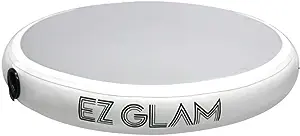 | Check the Latest Price on Amazon |
| Incline Mat |  | Check the Latest Price on Amazon |
I recommend using an incline mat for springboard drills as they can be used in lots of ways. The main two uses are either as a platform before the board to jump down from or after the board so that gymnasts can jump or roll onto the incline.
Additionally, they are useful for Handstand Flat Back, Handstand Fall to Bridge or in place of Stacked Mats (see below).
Body Shaping At Home
A strong handstand position and a solid round-off are crucial for vault success. Take plenty of time to correct and strengthen the body shapes needed to perform these skills.
1. Wall Handstand Drill: Holding a handstand against the wall helps with alignment, body tension, and shoulder strength.
2. Round-off Snap Down: Execute a round-off followed by a snap-down onto a mat. This focuses on fast hand placement and a powerful snap-down, crucial for the Tsukahara vault.
3. Handstand Fall to Bridge: This exercise reinforces a straight body line from hands to feet. From a handstand, gymnasts fall into a bridge position, emphasizing a tight body shape throughout.
4. Hollow Dish Holds. Dish the body by laying on the back and raising the head, shoulders and feet a few inches from the floor. Engage the core in order to hold the shape.
Vault onto Stacked Mats
Using stacked mats can safely simulate the vault table’s height and provide a progressive approach. The mats allow gymnasts to land on their back or front instead of having to worry about landing on feet. This allows the focus to shift onto technique and shape rather than landing.
1. Rebound up: Stack mats to a comfortable height. Gymnasts perform a range of jumps onto the mats, focusing on body shape and hand placement.
2. Handstand Flat Back: This drill helps in achieving a vertical handstand before the fall phase. Gymnasts kick to handstand on the stacked mats and fall flat onto a soft mat or resi-mat.
3. Half-On Drill: With mats simulating the vault table, gymnasts practice the half-on action, focusing on the turn and hand placement.
Vault and Stacked Mats Equipment
| Resi-Pit |  | Check the Latest Price on DGS |
| Vault Development System |  | Check the Latest Price on DGS |
| Vault Handspring Trainer |  | Check the Latest Price on DGS |
Landing Drills
A clean and safe landing is just as important as the vault itself.
1. Stick the Landing: Use a line or a beam on the floor. Gymnasts jump and turn, focusing on landing with feet together without moving.
2. Soft Mat Landings: Landing on a soft mat from a height helps gymnasts practice absorbing the impact, reducing the chance of injury.
3. Landing Position Practice: Without the vault, gymnasts practice the landing position, focusing on bent knees, chest up, and arms in front.
Conclusion
Knowing how to practice vault at home is essential if you want to avoid injuries and give yourself the best chance of improvement.
The drills and exercises mentioned above will guide gymnasts in refining their techniques, ensuring safety, and laying the groundwork for more advanced skills in the future. Remember, as with any sport, consistent practice, feedback, and determination are the keys to success.
FAQs
How do you judge a gymnastics vault?
Judging a gymnastics vault involves assessing both the execution and difficulty of the vault. Here’s a breakdown:
- Difficulty Score (D-Score): This score is predetermined based on the complexity and risk associated with the vault being performed. Higher-difficulty vaults can earn a gymnast more points.
- Execution Score (E-Score): Starting from a perfect 10, deductions are made for any flaws in the gymnast’s performance, such as form breaks, bent arms or legs, steps on the landing, or deviations from the center line.
- Final Score: The D-Score and E-Score are combined to produce the final score for the vault.
How can I improve my vault at home?
Certain parts of gymnastics vault training require specialized equipment and lots of space. At home try to focus on low-risk training activities such as the run-up, body shaping and strength work.
What is the hardest skill on vault?
Vault skills are rated by difficulty and agreed upon by the Federation of International Gymnastics (FIG). The hardest vaults include the Ri Se Gwang and The Shirai.
Do female gymnasts do vault?
Yes, both female and male gymnasts compete vault in artistic gymnastics.
- Why Do Gymnasts Wear Leotards (A Fascinating History)Gymnastics is a sport that has been around for centuries. With its roots tracing back to ancient Greece, gymnastics has come a long way since… Read more: Why Do Gymnasts Wear Leotards (A Fascinating History)
- A Complete Guide on What To Wear To GymnasticsWondering what to wear to gymnastics? We’ve got you covered as your child embarks on their gymnastics journey. In this comprehensive guide, we’ll provide you… Read more: A Complete Guide on What To Wear To Gymnastics
- Self Taught Gymnastics: A Good Idea or Not?Over the last twenty years as a gymnastics coach I have seen a huge increase in the number of children (and numerous adults) that have… Read more: Self Taught Gymnastics: A Good Idea or Not?
- Why Is Gymnastics So Expensive?Why is gymnastics so expensive? It’s a question that echoes through the halls of gyms and the minds of parents when they see the next… Read more: Why Is Gymnastics So Expensive?
- Is Gymnastics Harder Than Football?Many people wonder how hard gymnastics really is compared to other sports. In this article, I will analyze different elements of both gymnastics and football… Read more: Is Gymnastics Harder Than Football?
- Can You Start Gymnastics at 13?Can you start gymnastics at 13? Absolutely, and here’s the kicker – it’s never too late to flip your way into the world of gymnastics.… Read more: Can You Start Gymnastics at 13?
